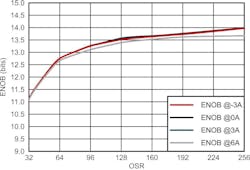TI Offers Functionally Isolated Modulators for Precision Robotics Control
Texas Instruments’ functionally isolated modulators are designed to empower engineers in developing more precise motor control systems for compact robotic designs. The products—the AMC0106M05, AMC0136 and AMC0106M25—achieve an effective number of bits (ENOB) ranging from 12 to 14, enabling precise phase current sensing and DC voltage measurement.
These isolated modulators, housed in a small leadless package measuring 3.5 mm × 2.7 mm, are made to increase the accuracy and efficiency of robotics applications while reducing the required board space by 50% compared with competing reinforced isolation solutions. This reduction in size presents designers with additional space to integrate more features that enhance motor control and ensure reliable operation in low voltage (<60V) robotics applications.
With the growing demand for smarter robotics capable of undertaking detailed tasks, TI says its modulators support engineers in achieving precise motor control and system protection. This advancement is designed to be advantageous in applications that require high precision, such as threading a needle or manipulating small components like nuts and bolts. The modulators are available in production quantities and offered in an 8-pin very thin small outline (VSON) package. To assist designers, evaluation models for all three new modulators, along with reference designs and simulation models, are also available.
Machine Design had some follow-up questions about the modulators, so we reached out to Martin Staebler, systems engineer for the Industrial Systems Motor Drive team at TI.
Editor’s note: Questions and answers may be edited for clarity.
Machine Design: What key mechanical design considerations should engineers keep in mind when integrating functionally isolated modulators into compact robotics and machinery applications?
Martin Staebler: We see at least two advantages with respect to mechanical designs: form factor including height and ambient temperature range. The AMC0106M05 comes with a small form factor leadless QFN package and help design smaller printed-circuit boards, hence the size of the inverter housing can be smaller—and the smaller form factor even enables integrating the 3-phase inverter into the motor housing. For motor integrated electronics typically 125°C ambient temperature rated components like the AMC0106M05 are required.
MD: In terms of thermal management and physical integration, what considerations should MD’s audience of engineers keep in mind when incorporating these modulators into compact robotic designs?
MS: As mentioned before, integration of the 3-phase inverter into the motor housing typically demands for 125°C ambient temperature rated components like the AMC0106M05. Another aspect is the selection of the phase current shunt, which connects to the AMC0106M05. The shunt resistance scales with full-scale current range.
The AMC0106 is offered with two input range variants: ±250mV and ±50mV. When selecting the shunt, the ±50mV version allows five times smaller shunt resistance. Due to that the shunt’s power dissipation is reduced by 80% at the same full-scale current range. Hence the AMC0106M05 helps choose a lower power rated and hence smaller formfactor shunt to further reduce the formfactor of the design.
The AMC0106 package does not consume much power and hence does not suffer self-heating, compared to in-package magnetic sensors, where the current flows through the package and heats up the device depending on its lead frame resistance.
MD: How can the increased resolution provided by the modulators impact the design decisions related to motor selection, control algorithms and system responsiveness to machinery?
MS: A higher resolution of the current, determined by the effective number of bits (ENOB), improves the phase current precision and hence the torque. A more precise and smooth torque enables a more accurate positioning. In addition a higher resolution in the current allows for improved sensorless control at low speed and standstill.
These methods inject small pulses on top of the space vector PWM. This pulses result in very small changes of the phase current. These changes may be within the noise floor of a system with 80 to 10 effective number of bits current. Hence a higher resolution up to 14 ENOB bit improves the ability to detect these patterns and improve the sensorless control. Higher resolution also helps detect low amplitude harmonics, which may be an indication of an upcoming bearing fault [and] improve predictive maintenance.
MD: What advantages do these modulators offer in terms of vibration resistance and durability, especially in demanding environments where robots might operate?
MS: Compared to closed-loop transformer based current transducers, solutions using a shunt and a semiconductor based modulators should be less sensitive to vibrations due to their lower weight and non-mechanical elements.
MD: Can you share any best practices for testing validating the performance of systems using these new modulators?
MS: I’d refer to the application note High Resolution, Small Form Factor Phase Current Sense for 48V Robotics and Servo Drives, which outlines test results of the AMC0106M05 with a 3-phase GaN-inverter driving a servo motor.
About the Author
Sharon Spielman
Technical Editor, Machine Design
As Machine Design’s technical editor, Sharon Spielman produces content for the brand’s focus audience—design and multidisciplinary engineers. Her beat includes 3D printing/CAD; mechanical and motion systems, with an emphasis on pneumatics and linear motion; automation; robotics; and CNC machining.
Spielman has more than three decades of experience as a writer and editor for a range of B2B brands, including those that cover machine design; electrical design and manufacturing; interconnection technology; food and beverage manufacturing; process heating and cooling; finishing; and package converting.
Email: [email protected]
LinkedIn: @sharonspielman
Facebook: Machine Design
YouTube: @MachineDesign-EBM


